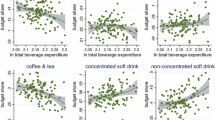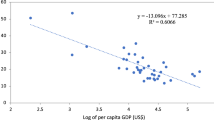Abstract
Using scanner data from a large European retailer, this paper empirically assesses deep habit formation in consumption. Deep habit formation constitutes a possible source of price stickiness and helps to mimic procyclical labour and real wage dynamics that are present in macrodata. To gauge the existence and the extent of deep habits in consumption, we estimate a dynamic time–space simultaneous model for consumption expenditure at different levels of product aggregation. This spatial panel model enables us to test for both internal and external deep habit formation at the same time. The former captures inertia or persistence in consumption and is included in the empirical specification as a time lag. The latter captures preference interdependence across households and is captured by a spatial lag. Our results show mixed evidence with respect to internal habit formation, whereas the external habit effect is almost always positive and significant.
Similar content being viewed by others
Notes
Due to a strict confidentiality agreement, we cannot disclose the identity of the retailer.
For an overview of all the product categories that we consider, the number of items in each category, the composition of the product groups, and the ten selected product categories for analysis at the individual product level, see Appendix A of Verhelst and Van den Poel (2012a).
1 month in fact amounts to exactly 4 weeks in our context. This is due to the fact that the retailer reviews prices every 2 weeks, so that it makes more sense to aggregate the data into stretches of 4 weeks rather than 1 month. We will ignore this timing issue in our analysis, and use the terms month and 4-week period interchangeably.
It would be highly interesting to see if e.g., people from the same income class buy similar products or brands. This is certainly an avenue for future research, based on a different set of data with more detailed individual customer characteristics.
Although the estimates remain unbiased and consistent, ignoring potential correlation between the error terms across equations could translate into a loss of efficiency. However, we believe that the impact of this will be very limited because the efficiency gain of taking into account the extra information in the correlation structure of the errors goes to zero when the correlation of the regressors is very high across equations. This is true for our systems, because we estimate the models across categories inside a certain product group, or across products inside a certain product category.
The empirical specification at the product group and individual product level is a straightforward variant of Eq. (1), taking into account the different level of product aggregation.
We do not incorporate potential spatial dependence in the error terms, as this would create severe identification problems. However, ignoring possible spatial autocorrelation among the errors only makes the estimates of the explanatory variables less efficient, preserving their unbiasedness and consistency (Elhorst 2010).
Since the spatial weights are endogenous, estimating them from the data would lead to severe identification problems (Korniotis 2010).
Yang and Allenby (2003) show that geographic reference groups are more important than demographic reference groups in determining individual preferences.
The time and spatial fixed effects can be concentrated out by taking the partial derivative of the log-likelihood function with respect to \(\tau _t\) and \(\mu _i\), respectively, and then substituting the solution back into the log-likelihood function. See Anselin et al. (2008), Lee and Yu (2010), and Elhorst (2010) for a full derivation.
In comparing the external deep habit parameters with their superficial benchmark, we should take into account the different definition of \(s\) across specifications. Whereas \(\rho \) in the aggregate model can be interpreted as an elasticity, this is only the case for the disaggregate models if the time-averaged value of \(s\) is identical across contiguous zip code areas.
For the full results, see Appendices B and C of Verhelst and Van den Poel (2012a).
For the full results, we again refer to Appendices B and C of Verhelst and Van den Poel (2012a).
References
Alessie R, Kapteyn A (1991) Habit formation, interdependent preferences and demographic effects in the almost ideal demand system. Econ J 101(406):404–419
Alvarez-Cuadrado F, Casado JM, Labeaga JM, Sutthiphisal D (2012) Envy and habits: panel data estimates of interdependent preferences. Banco de Espana Working Paper, No. 1213, p 48
Anselin L, Hudak S (1992) Spatial econometrics in practice: a review of software options. Reg Sci Urban Econ 22(3):509–536
Anselin L, Hudak S, Le Gallo J, Jayet H (2008) Spatial panel econometrics. In: Mátyás L, Sevestre P (eds) The econometrics of panel data. Springer, Heidelberg, pp 625–660
Arellano M, Bond S (1991) Some tests of specification for panel data: Monte Carlo evidence and an application to employment equations. Rev Econ Stud 58(2):277–297
Baltagi B (1980) On seemingly unrelated regressions with error components. Econometrica 48(6):1547–1551
Baltagi B (2008) Econometric analysis of panel data, 4th edn. Wiley, Chichester, p 351
Baltagi B (2011) Spatial panels. In: Ullah A, Giles D (eds) Handbook of empirical economics and finance. Chapman & Hall, London, pp 435–454
Baltagi B, Bresson G (2011) Maximum likelihood estimation and Lagrange Multiplier Tests for panel seemingly unrelated regressions with spatial lag and spatial errors: an application to Hedonic housing prices in Paris. J Urban Econ 69(1):24–42
Baltagi B, Pirotte A (2011) Seemingly unrelated regression with spatial error components. Empir Econ 40(1):5–49
Bell D, Song S, (2004). Social contagion and trial on the Internet: evidence from online grocery retailing. Wharton School Marketing Department Paper, p 45
Bradlow E, Bronnenberg B, Russell G, Arora N, Bell D, Duvvuri S, Ter Hofstede F, Sismeiro C, Thomadsen R, Yang S (2005) Spatial models in marketing. Mark Lett 16(3/4):267–278
Bronnenberg B (2005) Spatial models in marketing research and practice. Appl Stoch Models Bus Ind 21(4/5):335–343
Deaton A, Muellbauer J (1980) An almost ideal demand system. Am Econ Rev 70(3):312–326
Dossche M, Heylen F, Van den Poel D (2010) The kinked demand curve and price rigidity: evidence from scanner data. Scand J Econ 112(4):723–752
Elhorst P (2010a) Applied spatial econometrics: raising the bar. Spat Econ Anal 5(1):9–28
Elhorst P (2010b) Dynamic panels with endogenous interaction effects when T is small. Reg Sci Urban Econ 40(5):272–282
Elhorst P (2010c) Spatial panel data models. In: Fisher M, Getis A (eds) Handbook of applied spatial analysis. Springer, Heidelberg, pp 377–407
Elhorst P (2012) Dynamic spatial panels: models, methods, and inferences. J Geogr Syst 14(1):5–28
Fiebig D, Kim J (2000) Estimation and inference in SUR models when the number of equations is large. Econom Rev 19(1):105–130
Hsiao C (2003) Analysis of panel data, 2nd edn. Cambridge University Press, Cambridge, p 369
Jacob P (2010) Deep habits, price rigidities and the consumption response to government spending. UGent Working Paper, No. 10(641), p 35
Korniotis G (2010) Estimating panel models with internal and external habit formation. J Bus Econ Stat 28(1):145–158
Lee L, Yu J (2010a) A spatial dynamic panel data model with both time and individual fixed effects. Econom Theor 26(2):564–597
Lee L, Yu J (2010b) Some recent developments in spatial panel data models. Reg Sci Urban Econ 40(5):255–271
Manski C (1993) Identification of endogenous social effects: the reflection problem. Rev Econ Stud 60(3):531–542
Nakamura E, Steinsson J (2011) Price setting in forward-looking customer markets. J Monet Econ 58(3):220–233
Nickell S (1981) Biases in dynamic models with fixed effects. Econometrica 49(6):1417–1426
Ravina E (2007). Habit persistence and keeping up with the Joneses: evidence from micro data. Mimeo, p 58
Ravn M, Schmitt-Grohé S, Uribe M (2006) Deep habits. Rev Econ Stud 73(1):195–218
Ravn M, Schmitt-Grohé S, Uribe M (2012) Explaining the effects of government spending shocks. J Monet Econ 59(3):215–234
Verhelst B, Van den Poel D (2010) Price rigidity in Europe and the US: a comparative analysis using scanner data. UGent Working Paper, No. 10(684), p 32
Verhelst B, Van den Poel D (2012a) Deep habits in consumption: a spatial panel analysis using scanner data. UGent Working Paper, No. 12(823), p 32
Verhelst B, Van den Poel D (2012b) Implicit contracts and price stickiness: evidence from customer-level scanner data. UGent Working Paper, No. 12(776), p 26
Yang S, Allenby G (2003) Modeling interdependent consumer preferences. J Mark Res 40(3):282–294
Acknowledgments
The authors would like to thank Freddy Heylen, Gerdie Everaert, Gert Peersman, Emmanuel Dhyne, Sarah Lein and two anonymous referees for valuable comments. We have also benefited from comments received at the 18th International Conference on Computing in Economics and Finance (Prague, 2012) and the 6th World Conference of the Spatial Econometrics Association (Salvador de Bahia, 2012). We acknowledge support from the Belgian Program on Interuniversity Poles of Attraction, initiated by the Belgian State, Federal Office for scientific, technical and cultural affairs, contract UAP No. P 6/07. Benjamin Verhelst acknowledges financial support from the Research Foundation Flanders (FWO). Any remaining errors are ours.
Author information
Authors and Affiliations
Corresponding author
Rights and permissions
About this article
Cite this article
Verhelst, B., Van den Poel, D. Deep habits in consumption: a spatial panel analysis using scanner data. Empir Econ 47, 959–976 (2014). https://doi.org/10.1007/s00181-013-0776-4
Received:
Accepted:
Published:
Issue Date:
DOI: https://doi.org/10.1007/s00181-013-0776-4




